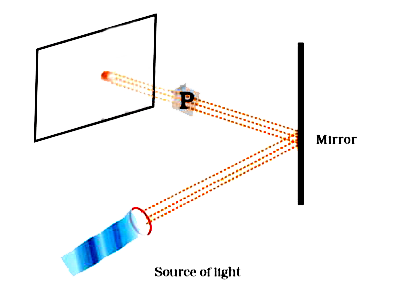In Fig. 11.11, a flower made of thick coloured paper has been pasted on the transparent glass sheet. What will be the shape and colour of shadow seen on the screen?

Shape- circular, colour- dark
Shape- circular, colour- light
Shape- flower, colour- dark
Shape- circular, colour- light
The correct Answer is:C
The shadow formed will be of the shape of the flower with its stalk, but, dark in colour.
Topper's Solved these Questions
- LIGHTBOOK - NCERT EXEMPLARCHAPTER - LIGHTEXERCISE - LONG ANSWER QUESTIONS
3 Videos
- LIGHTBOOK - NCERT EXEMPLARCHAPTER - LIGHTEXERCISE - LONG ANSWER QUESTIONS
3 Videos
- FUN WITH MAGNETSBOOK - NCERT EXEMPLARCHAPTER - FUN WITH MAGNETSEXERCISE - LONG ANSWER QUESTIONS
7 Videos
- MOTION AND MEASUREMENT OF DISTANCES BOOK - NCERT EXEMPLARCHAPTER - MOTION AND MEASUREMENT OF DISTANCES EXERCISE - LONG ANSWER QUESTIONS
4 Videos
Similar Questions
Two students made box-type solar cookers separately. They both painted the insulated box with black colour from inside, the cooking pots were painted black from outside, and a plane mirror reflector was also attached. One of the students covered the solar cooker box with a transparent glass sheet but the other student covered the solar cooker box with a transparent plastic sheet. Which of the two solar cookers will be more efficient and why ?
View SolutionA sheet of plywood, a piece of muslin cloth and that of a transparent glass, all of the same size and shape were placed at A one by one in the arrangement shown in Fig. 11.12. Will the shadow be formed in each case. If yes, how will the shadow on the screen be different in each case? Give reasons for your answer.

View Solution
Knowledge Check
A thin perfectly transparent glass sheet of thickness t and refractive index mu is pasted on one of the two identical slits. If the intensity of light at the centre of the screen is I0 in the absence of glass sheet, the intensity at O as a function of thickness of the glass plate is
AI0cos(μtλ)BI0cos2(μtλ)CI0cos2(π(μ−I)tλ)DI0cos(π(μ−I)tλ)A command that takes what has been typed into the computer and can be seen on the screen and sends it to the printer for output on paper ......
APrintBReturnCJumpDAttention1. The film industry is facing the challenge of the television screen which, because of its ready availability and nearness to entertainment seekers, is becoming very popular, particularly in the West where television programmes are as indispensable to people as newspaper material. Sustained entertainment for multitudes lasting two or three hours is possible only in big cinema halls. Scenic beauty, background effects and colour techniques which have made the products of cinema industry so attractive and delightful may not be reproduced by television programme organisers, and therefore, this important invention in the field of wireless communication, in spite of having become a big rival of the cinema, may not succeed in replacing it.
2. The motion picture has also stepped into the international sphere as an agent of goodwill and co-operation among nations. Cultural contacts which tend to reduce tension in the world and bring harmony in international relations have been established through the medium of films. The more people understand and appreciate the past history, present aims, customs, habits and beliefs of men and women in foreign lands, the more will they realise that their interests can best be served by establishing friendly relations with them and by removing those irritants which breed distrust, lack of co-operation and the desire to punish those whose views and attitudes are such as they do not like. As cultural agents movies can cement ties of love and brotherhood among nations and teach them to confer on each other the benefits of all the rich and glorious achievements of the present enlightened age. In recent years, artists of the film world have been visiting foreign lands with a view to presenting before audience in those countries the best products of their cultural heritage. Film festivals which many European and Asian countries have been organising from time to time have also proved to be of immense value in reducing social barriers, colour prejudices and other causes of friction between nations.
On the basis of your reading of the above passage answer the question:
The TV has become popular because of:Aits entertaining programmesBits educative valueCits ready availability and nearnessDits wide appeal
Observe the picture given in Fig. 11.6. A sheet of some material is placed at position ‘P’, still the patch of light is obtained on the screen. What is the type of material of this sheet?

View SolutionBasically all soaps are made by boiling fats or oils with suitable soluble hydroxide. Variations are made by using different raw materials.
Toilet soaps are prepared by using better grades of fats and oils and care is taken to remove excess alkali. Colour and perfumes are added to make these more attractive. Soaps that float in water are made by beating tiny air bubbles before their hardening. Transparent soaps are made by dissolving the soap in ethanol and then evaporating the excess solvent. In medicated soaps, substances of medicinal value are added. In some soaps, deodorants are added. Shaving soaps contain glycerol to prevent rapid drying. A gum called, rosin is added while making them. It forms sodium rosinate which lathers well. Laundry soaps contain fillers like sodium rosinate, sodium silicate, borax and sodium carbonate. Soap chips are made by running a thin sheet of melted soap onto a cool cylinder and scraping off the soaps in small broken pieces.
What is the general procedure of making soap ?
View Solution1. The film industry is facing the challenge of the television screen which, because of its ready availability and nearness to entertainment seekers, is becoming very popular, particularly in the West where television programmes are as indispensable to people as newspaper material. Sustained entertainment for multitudes lasting two or three hours is possible only in big cinema halls. Scenic beauty, background effects and colour techniques which have made the products of cinema industry so attractive and delightful may not be reproduced by television programme organisers, and therefore, this important invention in the field of wireless communication, in spite of having become a big rival of the cinema, may not succeed in replacing it.
2. The motion picture has also stepped into the international sphere as an agent of goodwill and co-operation among nations. Cultural contacts which tend to reduce tension in the world and bring harmony in international relations have been established through the medium of films. The more people understand and appreciate the past history, present aims, customs, habits and beliefs of men and women in foreign lands, the more will they realise that their interests can best be served by establishing friendly relations with them and by removing those irritants which breed distrust, lack of co-operation and the desire to punish those whose views and attitudes are such as they do not like. As cultural agents movies can cement ties of love and brotherhood among nations and teach them to confer on each other the benefits of all the rich and glorious achievements of the present enlightened age. In recent years, artists of the film world have been visiting foreign lands with a view to presenting before audience in those countries the best products of their cultural heritage. Film festivals which many European and Asian countries have been organising from time to time have also proved to be of immense value in reducing social barriers, colour prejudices and other causes of friction between nations.
On the basis of your reading of the above passage answer the question:
Film festivals have proved to be of immense value in reducing social barriers and colour among nations.
View Solution1. The film industry is facing the challenge of the television screen which, because of its ready availability and nearness to entertainment seekers, is becoming very popular, particularly in the West where television programmes are as indispensable to people as newspaper material. Sustained entertainment for multitudes lasting two or three hours is possible only in big cinema halls. Scenic beauty, background effects and colour techniques which have made the products of cinema industry so attractive and delightful may not be reproduced by television programme organisers, and therefore, this important invention in the field of wireless communication, in spite of having become a big rival of the cinema, may not succeed in replacing it.
2. The motion picture has also stepped into the international sphere as an agent of goodwill and co-operation among nations. Cultural contacts which tend to reduce tension in the world and bring harmony in international relations have been established through the medium of films. The more people understand and appreciate the past history, present aims, customs, habits and beliefs of men and women in foreign lands, the more will they realise that their interests can best be served by establishing friendly relations with them and by removing those irritants which breed distrust, lack of co-operation and the desire to punish those whose views and attitudes are such as they do not like. As cultural agents movies can cement ties of love and brotherhood among nations and teach them to confer on each other the benefits of all the rich and glorious achievements of the present enlightened age. In recent years, artists of the film world have been visiting foreign lands with a view to presenting before audience in those countries the best products of their cultural heritage. Film festivals which many European and Asian countries have been organising from time to time have also proved to be of immense value in reducing social barriers, colour prejudices and other causes of friction between nations.
On the basis of your reading of the above passage answer the question:
Three things which make cinema so attractive are:
View Solution1. The film industry is facing the challenge of the television screen which, because of its ready availability and nearness to entertainment seekers, is becoming very popular, particularly in the West where television programmes are as indispensable to people as newspaper material. Sustained entertainment for multitudes lasting two or three hours is possible only in big cinema halls. Scenic beauty, background effects and colour techniques which have made the products of cinema industry so attractive and delightful may not be reproduced by television programme organisers, and therefore, this important invention in the field of wireless communication, in spite of having become a big rival of the cinema, may not succeed in replacing it.
2. The motion picture has also stepped into the international sphere as an agent of goodwill and co-operation among nations. Cultural contacts which tend to reduce tension in the world and bring harmony in international relations have been established through the medium of films. The more people understand and appreciate the past history, present aims, customs, habits and beliefs of men and women in foreign lands, the more will they realise that their interests can best be served by establishing friendly relations with them and by removing those irritants which breed distrust, lack of co-operation and the desire to punish those whose views and attitudes are such as they do not like. As cultural agents movies can cement ties of love and brotherhood among nations and teach them to confer on each other the benefits of all the rich and glorious achievements of the present enlightened age. In recent years, artists of the film world have been visiting foreign lands with a view to presenting before audience in those countries the best products of their cultural heritage. Film festivals which many European and Asian countries have been organising from time to time have also proved to be of immense value in reducing social barriers, colour prejudices and other causes of friction between nations.
On the basis of your reading of the above passage answer the question:
The film industry is facing the challenge of:
View Solution
